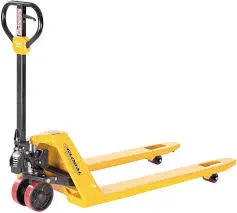


What is a Manual Pallet Jack?
A manual pallet jack, also known as a manual pallet truck or hand pallet jack, is an essential piece of equipment in warehouses, retail locations, and manufacturing facilities. Designed for lifting and moving palletized goods, it serves as a reliable tool for transporting materials without the need for electric power sources. This article will explore the key features, benefits, and applications of manual pallet jacks.
Key Features
Manual pallet jacks are typically constructed from durable steel frames, ensuring robustness and longevity even under heavy load conditions. The design includes two forks that slide under the pallets, allowing the operator to lift and move the load efficiently. The lift mechanism is powered by a hydraulic pump activated by a handle, enabling users to raise or lower the forks with minimal effort.
Most manual pallet jacks come with a weight capacity ranging from 2,000 to 5,000 pounds, accommodating various sizes and weights of pallets. The wheels are usually made of polyurethane or rubber, providing smooth maneuverability and protecting floors from damage. Some models also feature swivel wheels, allowing for easier navigation in tight spaces.
Benefits of Manual Pallet Jacks
1. Cost-Effectiveness Manual pallet jacks are generally more affordable than electric forklifts and other material handling equipment. They require no fuel or electricity, reducing operational costs significantly.
2. Simplicity of Use Operating a manual pallet jack is straightforward and does not require specialized training. Most employees can learn to operate it quickly, which reduces training time and enhances productivity.
3. Versatility These jacks can be used in various environments, including warehouses, retail stores, and manufacturing plants. They are ideal for transporting goods over short distances and can easily navigate through narrow aisles.

4. Enhanced Safety Manual pallet jacks are designed with safety features that minimize the risk of workplace accidents. With proper training, operators can handle heavy loads safely, reducing the chance of injury.
5. Environmental Impact Since manual pallet jacks do not rely on fuel or batteries, they contribute to a cleaner work environment. They emit no harmful gases, making them an eco-friendly option for material handling.
Applications
Manual pallet jacks are commonly used in various industries for multiple purposes. In warehouses, they are employed to move pallets from receiving areas to storage locations or loading docks. Retailers use them to transport goods from back rooms to sales floors, ensuring efficient inventory management.
In manufacturing settings, manual pallet jacks help move raw materials to production lines or finished products to shipping areas. Their ability to lift and transport heavy loads makes them invaluable in keeping operations running smoothly.
Moreover, these jacks can be instrumental in improving employee efficiency. By facilitating the quick and easy movement of products, manual pallet jacks enable workers to focus on other tasks, leading to higher productivity levels.
Conclusion
In conclusion, manual pallet jacks are a vital component of many material handling operations. Their affordability, ease of use, and versatility make them an ideal choice for businesses looking to enhance their logistics and supply chain processes. Whether in warehouses, retail outlets, or manufacturing plants, manual pallet jacks ensure that goods are moved safely and efficiently, contributing to overall operational success. Investing in quality manual pallet jacks can make a significant difference in productivity and safety in any workplace.



